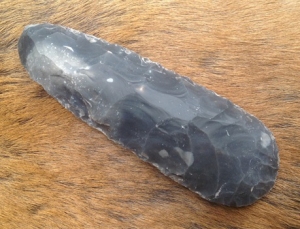Here, one of our talented replica makers James Dilley, of Ancient Craft, explains how he has made the flint axes for the houses.
The replica axes for the Neolithic houses had to manufactured by a technique known as “flintknapping” which is made up of the name of the material (flint) and the Germanic word – “knopp” which means to strike, shape or work. The flint itself is around 100 million years old and is extracted in Suffolk in a sand and gravel quarry (hence the orange/yellow cortex or skin). This kind of flint is very glassy and dark in colour which means the finished axes generally have a pleasing appearance. You may have spotted the safety glasses I am wearing; these prevent the sharp flakes damaging my eyes. It is very rare they fly upwards but they are always worth wearing for flintknapping.
My knapping tools consist of beach pebbles, some very hard to take large, thick flakes off while others a slightly softer so that the flakes are thinner and more controlled. I also use a rough sandstone pebble to dull the razor sharp edges before striking them. This means the edge will not shatter when I hit it but will instead allow the energy from the strike to continue into the flint. I have to strike around the edges to take flakes off and constantly survey my options and angles around the flint as I work to try and make use of every opportunity to take off a good flake. Sometimes there are natural cracks or fossils in the flint that hinder my flaking as they cause a stop in energy or alter the energy’s path.
As I continue to work around the nodule, it starts to take shape as the cortex disappears. This stage is considered the “roughout” stage. Neolithic mining and extraction sites would have produced roughouts from raw nodules before transporting them around the UK for final flaking and polishing. As the roughout gets smaller with each flake I will consider down grading my hammer stone to a smaller size for greater precision and control, the main requirement for good knapping is strike accuracy.
At this stage before the final shaping I can decide the form and shape of the axe head so that I can create a strategy to follow. The roughout is also fairly thin at this stage so I need to be extra careful not to strike it too hard and break it. Archaeologists have found many broken axes which have been damaged during manufacture or use leaving distinctive break marks.
Here is the finished axe head. Next it could be polished but this one will remain flaked, the next thing it will need is a handle or haft.





Pingback: Your chance to get involved with the Neolithic Houses | Stonehenge Neolithic Houses